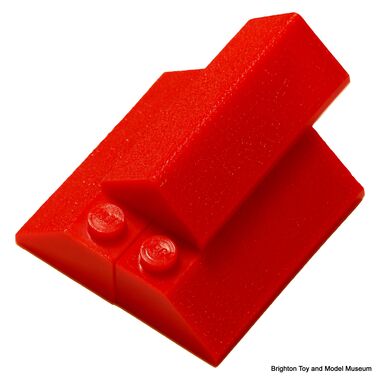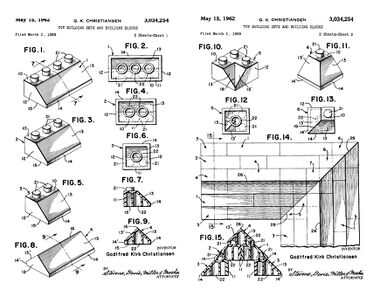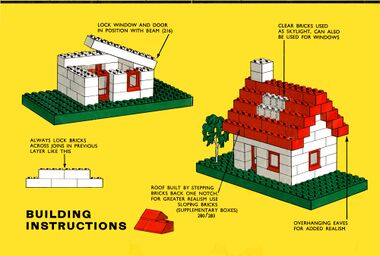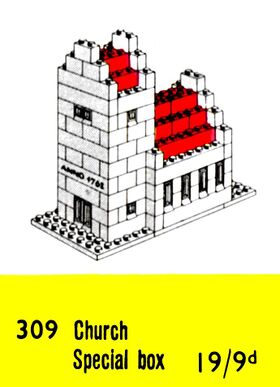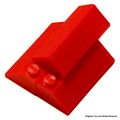Category:Lego roof bricks
Bricks: Original
|| Transitional
|| Modern
Town Plan
|| Cars
|| Roofs
|| Windows and Doors
|| Wheels
Lego Roof Bricks, closeup [image info]
1959 patent application for the Lego roof bricks. [image info]
~1964: Lego instructions, for roofs with and without the new roof bricks [image info]
309 Church - apparently the first Lego set to include a stepped roof [image info]
One of the immediate advantages of the new redesigned "1958" Lego bricks (with their new internal structures) was that a brick no longer needed to clip to a 2×2 or larger cluster of bricks - it could clip to a single row (with an offset), or even to a single stud.
Stepped roofs
With these offsets, one could easily place bricks that jutted outwards or inwards from a wall, and build hollow stepped roofs. If one tried this with the earlier Page bricks, a roof would have to be at least semi-solid, or else the half-supported bricks would simply fall inwards. This hadn't been a huge problem for the Page sets since they included cardboard roofs, but Lego didn't want to incorporate cardboard, because it undermined the image that they were trying to project, of using only the best quality materials.
In the buildings for the Lego City Plan Set, it's notable that Lego embraced modern Art Deco design, and used single-storey buildings and tower blocks with flat roofs ... which also kept the part-count low (except for Church 309, apparently first released in 1958, which showed off the new ability of the bricks to produce a stepped roof).
The dedicated roof bricks
Although the stepped roofs worked well structurally, they were not exactly elegant or realistic. The obvious thing to do if one was looking to produce variations on the new bricks was to produce versions with an upper row of studs removed and replaced with a slope ... which Lego duly did, filing a UK patent in 1959.
Lego didn't just produce sloped versions of the 2×2 and 2×4 bricks to allow staggering, they also produced 3×2's, and "apex" roof bricks with slopes on both sides ... and for a bit of sophistication, also corner bricks with a pair of 90-degree-angles convex or concave slopes, to allow quite sophisticated roofing designs with intersecting roofways and jutting gables.
The number of different slope variants meant that Lego ended up with three separate accessory packs for the "normal" roof bricks, plus a fourth for the more "exotic" convex and concave corner versions. Given that Lego bricks were supposed to be general-purpose, Lego may have been a little uncomfortable about the number of different custom roof bricks, and their UK pack descriptions don't use the word "roof", and only talk about "bevels", "angles" and "valleys" ... although the bricks were quite obviously meant for roofing, and some of the types were of almost no use for anything else.
The persistence of blocky roofs
It's perhaps surprising that even some years after launching the roof bricks, Lego were still promoting designs with "blocky" stepped roofs, presumably because some of the more specialised roof pieces had limited applications, whereas the parts used in a "blocky" roof had the advantage of being useable for lots of other things. This tension between whether one designs new custom parts that might only be single-purpose, or whether one stays with more generic general-purpose pieces has been an ongoing issue in the philosophy of Lego ever since, with the Lego Creator range appearing 2003 to answer complaints from customers that too many of the 1990s advanced sets had relied too much on custom pieces, which felt like "cheating".
This long-running conflict between "specialisation" and "generality" arguably goes all the way back to the introduction of the roof parts.
Pages in category ‘Lego roof bricks’
This category contains only the following page.
Media in category ‘Lego roof bricks’
The following 7 files are in this category, out of 7 total.
- Angle and Valley Corner Tiles, Lego Set 283 (LegoCat ~1960).jpg 689 × 952; 67 KB
- Bevelled Bricks, Lego Set 280 (LegoCat ~1960).jpg 689 × 952; 56 KB
- Bevelled Bricks, Lego Set 281 (LegoCat ~1960).jpg 689 × 952; 70 KB
- Bevelled Bricks, Lego Set 282 (LegoCat ~1960).jpg 689 × 952; 65 KB
- Lego Building Instructions (Lego ~1964).jpg 2,000 × 1,349; 296 KB
- Lego roof bricks (Lego, 1960s).jpg 2,500 × 2,500; 289 KB
- Lego Roof Bricks, lineart (Patent 3034254, 1959-1962).jpg 1,159 × 881; 215 KB
